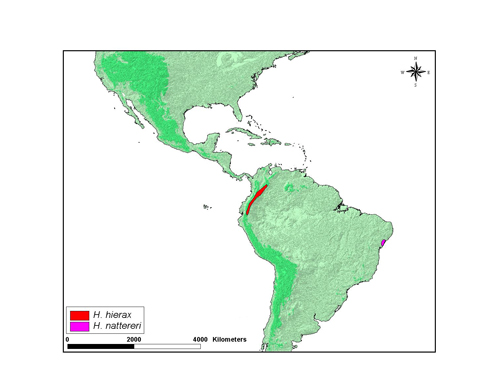Heliconius nattereri
Margarita Beltrán and Andrew V. Z. BrowerIntroduction
Heliconius nattereri is the rarest Heliconius species, occurring in small remnant pockets of the Atlantic Coastal Forest of Brazil. It is also the only Heliconius with sexually dimorphic wing patterns: the two sexes were originally described as separate species. The above images show the dorsal and ventral wing surfaces of male specimens captured in their native habitat. Females have tawny-colored wing pattern elements that cause them to resemble local H. ethilla and ithomiines such as Mechanitis polymnia.
Characteristics
Early stages: Eggs are cream and approximately 1.1 x 0.8 mm (h x w). Females usually place 1 to 3 eggs on growing shoots and tendrils of the host plant. Mature larvae have a white body with black spots, with black scoli and black and yellow head, length is around 1.8 cm. Caterpillars are gregarious (Brown, 1981).
Geographical Distribution
Heliconius nattereri is distributed in East Brazil (Bahia). The map below shows an approximate representation of the geographic distribution of this species. The original data used to draw these maps are derived from Brown (1979) which is available at Keith S. Brown Jr. (1979). Ecological Geography and Evolution in Neotropical Forests.
Habits
H. nattereri occurs from sea level to 1,300 m in humid forests. Usually males fly rapidly and in the canopy and females slowly and in the middlestory. Females mate multiply and adults roost solitarily or in loose groups at night at 2-10 m above ground on twigs or tendrils.
Hostplant: H. nattereri larvae feed primarily on plants from the genera Tetrastylis and Dilkea (Brown, 1981).
References
Brown, K. S., Jr. 1970 Rediscovery of Heliconius nattereri in eastern Brazil. Entomol. News 81, 129-140.
Brown, K. S., Jr. 1972 The heliconians of Brazil (Lepidoptera: Nymphalidae). Part III. Ecology and biology of Heliconius nattereri, a key primitive species near extinction, and comments on the evolutionary development of Heliconius and Eueides. Zoologica NY 57, 41-69.
Brown K. S. 1981 The Biology of Heliconius and Related Genera. Annual Review of Entomology 26, 427-456.
Felder C. Felder R. 1865. Reise der österreichischen Fregatte Novara um die Erde in den Jahren 1857, 1858, 1859 unter den Befehlen des Commo-dore B. von Wüllerstorf-Urbair. Zoologischer Theil. Zweiter Band. Zweite Abtheilung: Lepidoptera. Wien, Carl Gerold's Sohn. (1): [4] + 1-136, pls. 1-21.
Title Illustrations

| Scientific Name | Heliconius nattereri |
|---|---|
| Location | Brazil: Bahia, Serra Bonita Reserve |
| Specimen Condition | Live Specimen |
| Identified By | Andrew V. Z. Brower |
| Sex | Male |
| Life Cycle Stage | adult |
| View | dorsal |
| Image Use |
 This media file is licensed under the Creative Commons Attribution-NonCommercial License - Version 3.0. This media file is licensed under the Creative Commons Attribution-NonCommercial License - Version 3.0.
|
| Copyright |
© 2010

|
| Scientific Name | Heliconius nattereri |
|---|---|
| Location | Brazil: Bahia, Serra Bonita Reserve |
| Specimen Condition | Live Specimen |
| Identified By | Andrew V. Z. Brower |
| Sex | Male |
| Life Cycle Stage | adult |
| View | ventral |
| Image Use |
 This media file is licensed under the Creative Commons Attribution-NonCommercial License - Version 3.0. This media file is licensed under the Creative Commons Attribution-NonCommercial License - Version 3.0.
|
| Copyright |
© 2010

|
About This Page

University of Cambridge, Cambridge, UK

Middle Tennessee State University, Murfreesboro, Tennessee, USA
Correspondence regarding this page should be directed to Margarita Beltrán at and Andrew V. Z. Brower at
Page copyright © 2010 and
 Page: Tree of Life
Heliconius nattereri .
Authored by
Margarita Beltrán and Andrew V. Z. Brower.
The TEXT of this page is licensed under the
Creative Commons Attribution-NonCommercial-ShareAlike License - Version 3.0. Note that images and other media
featured on this page are each governed by their own license, and they may or may not be available
for reuse. Click on an image or a media link to access the media data window, which provides the
relevant licensing information. For the general terms and conditions of ToL material reuse and
redistribution, please see the Tree of Life Copyright
Policies.
Page: Tree of Life
Heliconius nattereri .
Authored by
Margarita Beltrán and Andrew V. Z. Brower.
The TEXT of this page is licensed under the
Creative Commons Attribution-NonCommercial-ShareAlike License - Version 3.0. Note that images and other media
featured on this page are each governed by their own license, and they may or may not be available
for reuse. Click on an image or a media link to access the media data window, which provides the
relevant licensing information. For the general terms and conditions of ToL material reuse and
redistribution, please see the Tree of Life Copyright
Policies.
- First online 18 February 2007
- Content changed 21 June 2010
Citing this page:
Beltrán, Margarita and Andrew V. Z. Brower. 2010. Heliconius nattereri . Version 21 June 2010 (under construction). http://tolweb.org/Heliconius_nattereri/72908/2010.06.21 in The Tree of Life Web Project, http://tolweb.org/







 Go to quick links
Go to quick search
Go to navigation for this section of the ToL site
Go to detailed links for the ToL site
Go to quick links
Go to quick search
Go to navigation for this section of the ToL site
Go to detailed links for the ToL site